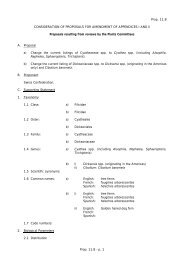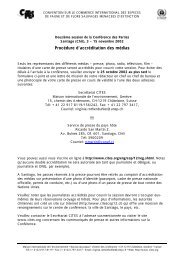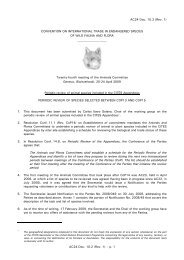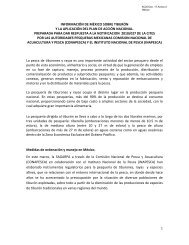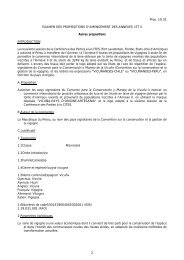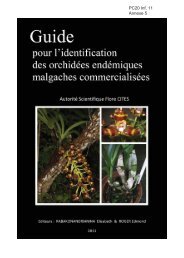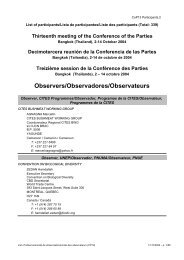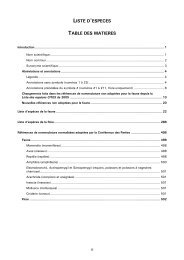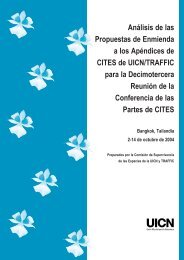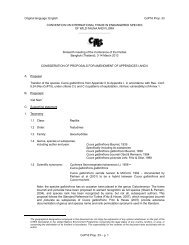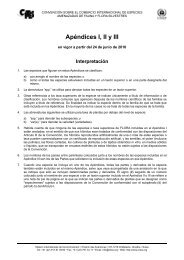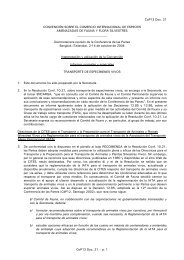Lamna nasus - Cites
Lamna nasus - Cites
Lamna nasus - Cites
You also want an ePaper? Increase the reach of your titles
YUMPU automatically turns print PDFs into web optimized ePapers that Google loves.
Draft Proposal to list <strong>Lamna</strong> <strong>nasus</strong> in Appendix II - prepared by Germany in January 2012<br />
Others: Porbeagle hides can be processed into leather, and liver oil extracted (Vannuccini 1999, Fischer et al.<br />
1987), but trade records are not kept. Cartilage is probably also processed and traded. Other shark parts are<br />
used in the production of fishmeal, which is probably not a significant product from L. <strong>nasus</strong> fisheries because<br />
of the high value of the species’ meat (Vannuccini 1999).<br />
6.4 Illegal trade<br />
Although no legislation has been adopted by range States or trading nations to regulate national or<br />
international trade in <strong>Lamna</strong> <strong>nasus</strong>, the increased application of strict quota management (including the EU<br />
zero quota) increases the risk of illegal trade transactions and shipments taking place, particularly in the<br />
absence of trade monitoring and regulation at species level.<br />
6.5 Actual or potential trade impacts<br />
The unsustainable L. <strong>nasus</strong> fisheries described above have been driven by the high value of the meat in<br />
national and international markets. Trade has therefore been the driving force behind the depletion of<br />
populations in the North Atlantic and, with the closure of the major northern fisheries, now threatens Southern<br />
Hemisphere populations. Southern populations are of particular concern because they are intrinsically even<br />
more vulnerable to over-exploitation in fisheries than are the depleted northern stocks.<br />
7. Legal instruments<br />
7.1 National<br />
It has been forbidden to catch and land porbeagle in Sweden since 2004.<br />
The Committee on the Status of Endangered Wildlife in Canada (COSEWIC) designated L. <strong>nasus</strong> as<br />
Endangered in 2004 (COSEWIC 2004). The Federal Government of Canada declined to list the species under<br />
Schedule 1 of Canada’s Species at Risk Act (SARA) because recovery measures were already being<br />
implemented.<br />
7.2 International<br />
‘Family Isurida’ (now Lamnidae, including L. <strong>nasus</strong>) is listed in Annex 1 (Highly Migratory Species) of the<br />
UN Convention on the Law of the Sea (UNCLOS). The UN Agreement on Straddling Fish Stocks and Highly<br />
Migratory Fish Stocks, in force since 2001, establishes rules and conservation measures for high seas fisheries<br />
resources. It directs States to pursue co-operation in relation to listed species through appropriate sub-regional<br />
fisheries management organisations or arrangements, but there has not yet been any progress with<br />
implementation of oceanic shark fisheries management.<br />
<strong>Lamna</strong> <strong>nasus</strong> is listed in Annex III, ‘Species whose exploitation is regulated’ of the Barcelona Convention<br />
Protocol concerning specially protected areas and biological diversity in the Mediterranean. This population<br />
was also added in 1997 to Appendix III of the Bern Convention (the Convention on the Conservation of<br />
European Wildlife and Natural Habitats) as a species whose exploitation must be regulated in order to keep its<br />
population out of danger. No management action has yet followed these listings.<br />
L. <strong>nasus</strong> is included in Appendix II of the Convention on the Conservation of Migratory Species (CMS). CMS<br />
is currently developing an instrument for the conservation of migratory sharks, which may in due course<br />
stimulate conservation actions for the species.<br />
L. <strong>nasus</strong> is included in the OSPAR Convention for the Protection of the Marine Environment of the North-east<br />
Atlantic list of Threatened and/or Declining Species and Habitats. This list, developed under Annex V on the<br />
Protection and Conservation of the Ecosystems and Biological Diversity of the OSPAR Maritime Area,<br />
identifies species and habitats in need of protection or conservation. Proposals for actions, measures and<br />
monitoring that should be undertaken for this species will be considered in late 2009.<br />
8. Species management<br />
8.1 Management measures<br />
The International Plan of Action (IPOA) for the Conservation and Management of Sharks urges all States with<br />
shark fisheries to implement conservation and management plans, but is voluntary. Of the top 20 shark fishing<br />
entities, which account for nearly 80% of the world’s shark catch, only 13 are known to have a National Shark<br />
Plan (Lack and Sant 2011), although FAO (2010) reported that 65% of Members that responded to a survey<br />
Page 11 of 14<br />
AC26 Doc. 26.2, Annex 1 – p. 11<br />
AC26 Doc. 26.2<br />
Annex / Anexo /Annexe<br />
(English only / únicamente en inglés / seulement en anglais)




